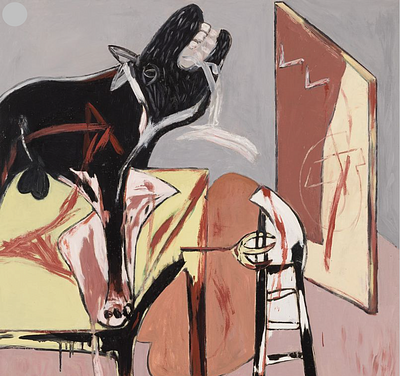ANTONIO SAURA (Huesca, 1930 - Cuenca, 1998). "Mutation", 1980. Ink on paper.
Lot 84
About Seller
Setdart Auction House
Carrer Aragó 346
Barcelona
Spain
Setdart Subastas was born in 2004 and is currently the first online art auction in Spain with solidity, prestige and reliability guaranteed by our more than 60,000 users. Setdart has a young, dynamic and enterprising team ready to successfully manage the purchase and sale of art works through custom...Read more
Categories
Estimate:
EUR€45,000 - EUR€55,000
$48,913.04 - $59,782.61
Absentee vs Live bid
Two ways to bid:
- Leave a max absentee bid and the platform will bid on your behalf up to your maximum bid during the live auction.
- Bid live during the auction and your bids will be submitted real-time to the auctioneer.
Bid Increments
| Price | Bid Increment |
|---|---|
| EUR€0 | EUR€10 |
| EUR€200 | EUR€25 |
| EUR€500 | EUR€50 |
| EUR€1,000 | EUR€100 |
| EUR€3,000 | EUR€200 |
| EUR€5,000 | EUR€500 |
| EUR€10,000 | EUR€1,000 |
| EUR€20,000 | EUR€2,000 |
| EUR€50,000 | EUR€5,000 |
About Auction
By Setdart Auction House
Nov 16, 2021
Set Reminder
2021-11-16 08:00:00
2021-11-16 08:00:00
America/New_York
Bidsquare
Bidsquare : Contemporary and Actual Art
https://www.bidsquare.com/auctions/setdart-auction-house/contemporary-and-actual-art-7839
Setdart Auction House sofia@setdart.com
Setdart Auction House sofia@setdart.com
- Lot Description
ANTONIO SAURA (Huesca, 1930 - Cuenca, 1998). "Mutation", 1980. Ink on paper. Signed and dated in the lower right corner. Attached certificate issued by Archives Antonio Saura. This work will be included in the Catalogue Raisonné of artist, still in realization. Measurements: 70 x 100 cm. We are in front of an overwhelming and introspective work, determined by the chaos of strokes and by the chromatism restricted to blacks and whites. Mutation, together with other themes such as crucifixions or crowds of people, were a regular feature in Saura's works. The gestural painting, the repetition of forms, the intensity of the strokes and the interweaving of the unrepeatable and random forms that are the protagonists of these works, allude to Saura's experience with the Spanish Civil War, a key episode in the Hispanic plastic arts associated with Black Spain and the tragedy lived in the last years of our country. Self-taught, Antonio Saura began to paint and write in Madrid in 1947. Three years later he held his first individual exhibition at the Libros bookstore in Zaragoza, showing a series of experimental works ("Constelaciones" and "Rayogramas"), created during the long illness that kept him immobilized since 1943, for a period of five years. In 1952 he held his first exhibition in Madrid, at the Buchholz bookstore, where he exhibited his youthful, dreamlike and surrealist works. That same year he visited Paris for the first time, settling in the city. There his work was influenced by artists such as Miró and Man Ray, and he dedicated himself to making paintings on canvas and paper of an organic nature, using various techniques. The break with the surrealist group allows him to open up to other ways of creation, where he begins to show the evolution that his work is undergoing, which moves towards an instantaneous painting of gestural strokes and reduced palette of selective character, where informalism plays the misleading between suggestive expressions of line and color. He made his debut in Paris in 1957, at the Stadler Gallery, the same year he founded the El Paso group. The following year he participates in the Venice Biennale in the company of Chillida and Tàpies, and in 1960 he receives the Guggenheim Prize in New York. In 1963 his first retrospectives were held at the Stedelijk Museum in Eindhoven, the Rotterdamsche Kunstring and the museums of Buenos Aires and Rio de Janeiro (works on paper). Saura's retrospective exhibitions are repeated throughout his career, both in Spain and in Europe and America. In 1966 he exhibits at the Institute of Contemporary Arts in London, and participates in the Biennial of Engraving "Bianco e Nero" of Lugano, obtaining the Grand Prize. The following year he settled in Paris, although he worked and spent every summer in Cuenca, a fundamental pillar of his production since his early years. In 1968 he abandoned oil painting to devote himself exclusively to works on paper. In 1979 he was awarded a prize at the First Biennial of engraving in Heidelberg, in 1981 he was named Knight of the Order of Arts and Letters in France, and the following year he was awarded the Gold Medal of Fine Arts. He has exhibited all over the world and is represented in the most important national and international contemporary art museums, including the Neue Nationalgalierie in Berlin, the Guggenheim in Bilbao, the Museo Nacional Centro de Arte Reina Sofía, the Albright-Knox Art Gallery in Buffalo, the Guggenheim and the Metropolitan in New York, the Centre Georges Pompidou in Paris and the Tate Gallery in London.
- Shipping Info
-
In-house shipping available. Please inquire at admin@setdart.com.
-
- Buyer's Premium



 EUR
EUR CAD
CAD AUD
AUD GBP
GBP MXN
MXN HKD
HKD CNY
CNY MYR
MYR SEK
SEK SGD
SGD CHF
CHF THB
THB














